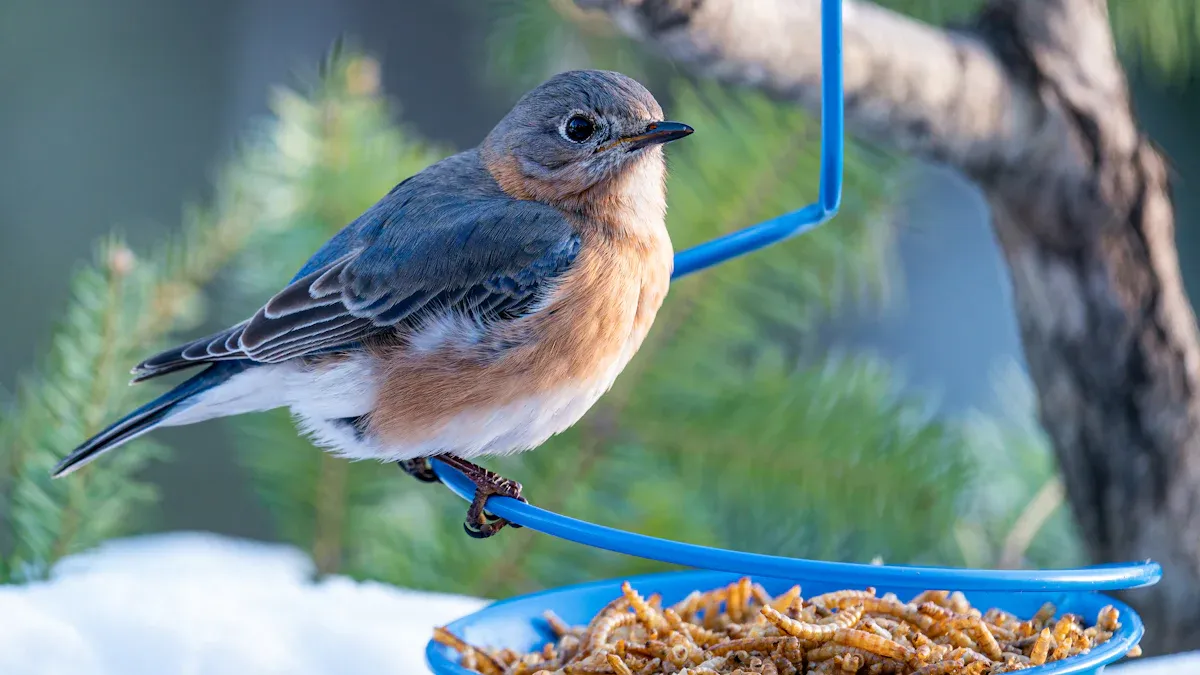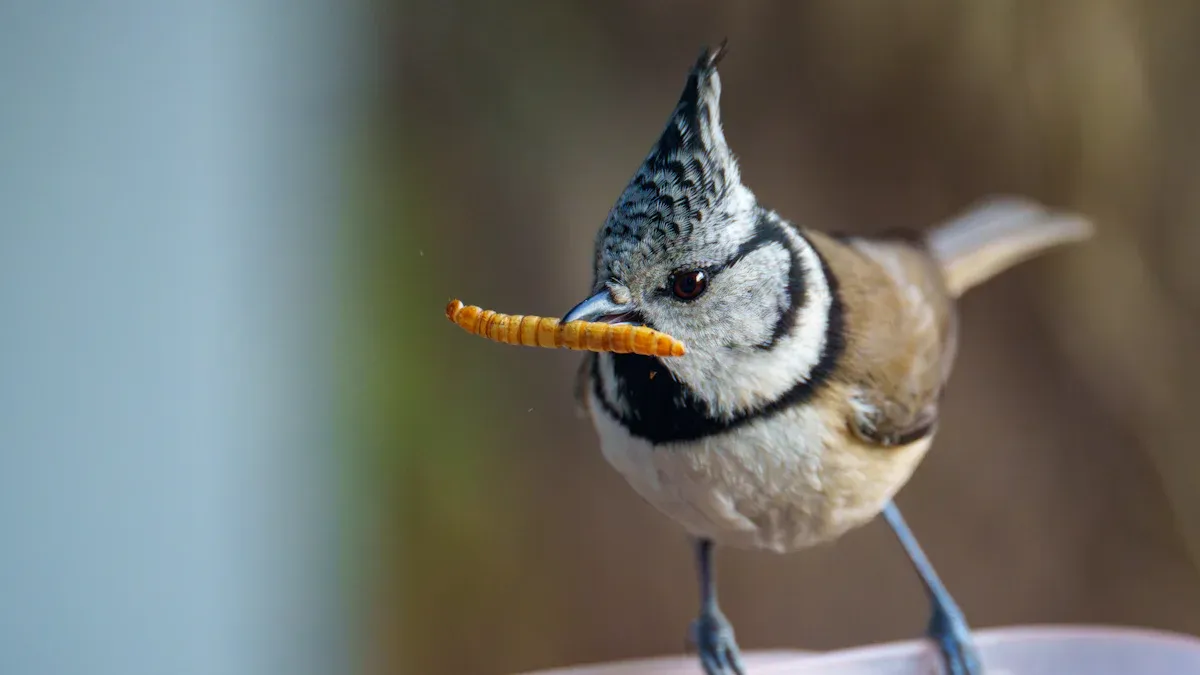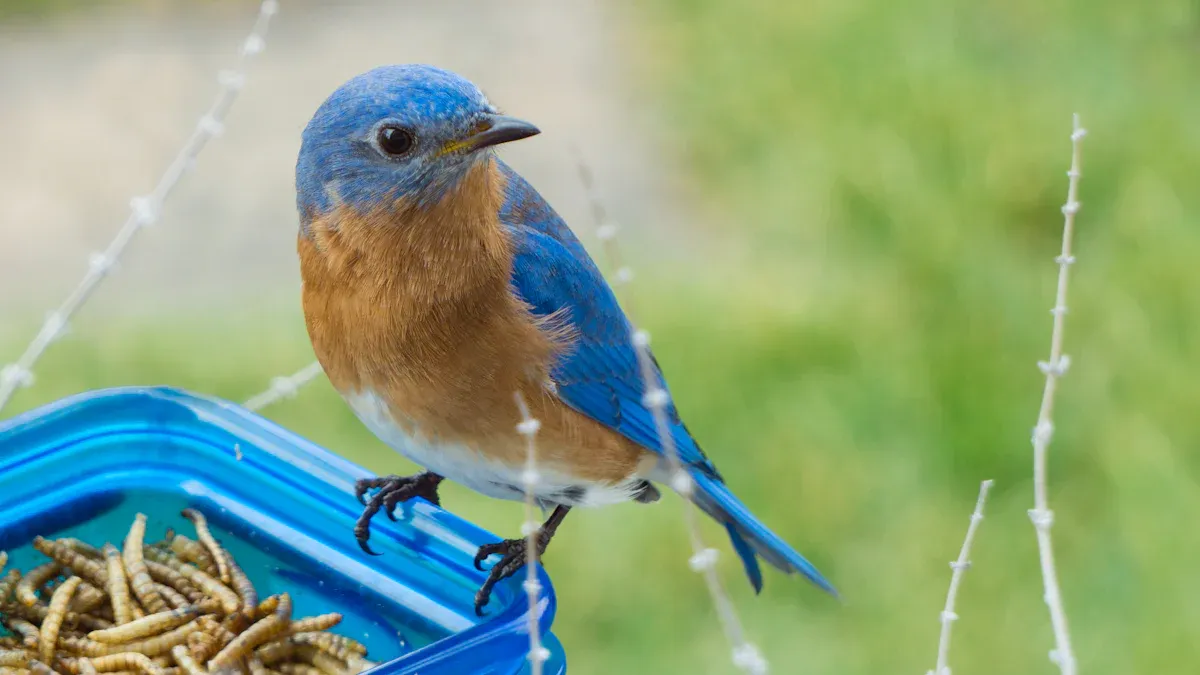
Mealworms are a favorite among birds. Packed with protein and fats, they help birds stay energetic during breeding and migration. Adding mealworms in bird food supports their health and encourages more species to visit. Whether it’s a backyard robin or a migrating warbler, mealworms keep them thriving year-round.
Key Takeaways
- Mealworms are healthy for birds. They have lots of protein and fat, which give energy and keep birds strong all year.
- Putting out mealworms can bring many bird types to your yard. Even shy birds might come if you use mealworms.
- Storing mealworms the right way is important. Keep live mealworms in the fridge. Store dried ones in a cool, dry spot to keep them fresh.
Nutritional Benefits of Mealworms in Bird Food

High Protein and Fat Content for Energy
Mealworms pack a punch when it comes to nutrition. Their high protein content, ranging from 40.7% to 52.3%, makes them an excellent energy source for birds. Protein helps birds maintain their strength and stamina, especially during demanding times like migration. Alongside protein, mealworms contain beneficial fats, including oleic acid, which can make up 30% to 60% of their fat profile. These fats provide birds with the energy they need to stay active and healthy.
Here’s how mealworms compare to other common bird feeds:
| Feed Type | Crude Protein (%) | Crude Fat (%) |
|---|---|---|
| Mealworms | 59.2 | 24 |
| Soybean Meal | 44 | 0.5 |
Mealworms clearly outperform traditional options like soybean meal in both protein and fat content. This makes them a superior choice for bird feeding.
Essential Nutrients for Breeding and Molting
Birds need extra nutrients during breeding and molting seasons. Mealworms provide essential amino acids that support feather growth and repair. These nutrients also help birds produce healthy eggs and care for their chicks. Unlike some traditional feeds, mealworms offer a sustainable and environmentally friendly source of protein and fat, which enhances bird nutrition during these critical periods.
Did you know? Insects like mealworms have a much higher conversion efficiency compared to traditional feed sources. This means birds get more nutrition from every bite, making mealworms a smart choice for bird enthusiasts.
Year-Round Benefits for Wild Birds
Mealworms in bird food aren’t just for special seasons—they’re beneficial all year long. During winter, their high-fat content helps birds stay warm and energized. In spring and summer, mealworms provide the protein birds need for nesting and raising their young. Even in fall, when birds prepare for migration, mealworms offer the nutrients they need to build up their strength.
Whether you’re feeding backyard birds or supporting migratory species, mealworms are a versatile and nutritious option. They can be used alone in a feeder or mixed with birdseed to attract a variety of species.
Bird Species That Eat Mealworms
Common Backyard Birds That Love Mealworms
Mealworms are a favorite treat for many backyard birds. Species like bluebirds, robins, and chickadees eagerly snack on them. These birds rely on protein-rich foods to stay active and healthy. Cardinals and woodpeckers also enjoy mealworms, especially during nesting season. Offering mealworms in bird food can attract these colorful visitors to your yard.
Bird enthusiasts often notice that mealworms bring shy birds out of hiding. Wrens and nuthatches, for example, are more likely to visit feeders stocked with mealworms. This makes them an excellent choice for anyone hoping to observe a wider variety of birds up close.
Seasonal and Migratory Birds
Seasonal and migratory birds benefit greatly from mealworms. During migration, birds need extra energy to fuel their long journeys. Mealworms provide the perfect combination of protein and fat to meet these needs. Studies show that migratory birds consume more energy-dense foods during this time.
| Batch | Energy Density (kJ g–1 wet mass) | Statistical Significance |
|---|---|---|
| 1 | 10.06 (SD = 0.15, n = 3) | P < 0.001 |
| 2 | 11.35 (SD = 0.16, n = 5) | P < 0.001 |
This data highlights how mealworms can support birds during their most demanding seasons.
Supporting Insect-Eating Birds with Mealworms
Insect-eating birds thrive on mealworms. Species like warblers, flycatchers, and swallows depend on insects for survival. Mealworms mimic their natural diet, making them an ideal supplement. By offering mealworms, bird lovers can help these birds find food, especially when insects are scarce.
Tip: Sprinkle mealworms on the ground to encourage foraging behavior in insect-eating birds.
How to Feed Mealworms to Birds

Choosing the Right Feeder for Mealworms
Selecting the right feeder is key to successfully offering mealworms to birds. Shallow dishes with smooth sides work best for live mealworms. These feeders prevent the worms from escaping while keeping them accessible to birds. For dried mealworms, a mesh feeder or a platform feeder is ideal. These designs allow birds to easily spot and grab the mealworms without scattering them.
Some feeders come with covers to protect the mealworms from rain or pests. This feature is especially useful for outdoor feeding. Positioning feeders near perches or branches can make them more inviting to birds. Birds feel safer when they can quickly retreat to a nearby perch after feeding.
Tip: Experiment with different feeder types to see which one attracts the most birds to your yard.
Placement Tips for Maximum Visibility
Where you place the feeder matters as much as the feeder itself. Birds are more likely to visit feeders placed in open, visible areas. Position the feeder near shrubs or trees to provide birds with a sense of security. Avoid placing feeders too close to dense foliage, as this can make it harder for birds to spot the mealworms.
If you’re feeding insect-eating birds, sprinkle mealworms on the ground near the feeder. This encourages natural foraging behavior. For backyard birds like robins and chickadees, placing the feeder at eye level can make it easier for them to find the food.
Patience is important when introducing mealworms to birds. It may take a few days for birds to discover the new food source. Once they do, you’ll likely see a steady stream of visitors.
Live vs. Dried Mealworms: Which to Choose
Both live and dried mealworms have their advantages, but the choice depends on your goals. Live mealworms are more appealing to birds because of their movement and taste. Birds like bluebirds and Carolina wrens prefer live mealworms, especially during nesting season. The hydration and energy provided by live mealworms make them ideal for supporting birds during critical periods.
Dried mealworms, on the other hand, are more convenient. They don’t require special storage and have a longer shelf life. The freeze-drying process preserves their nutritional value, making them a reliable source of protein and fats. Dried mealworms can be mixed with birdseed to create a balanced diet. However, they should be offered in limited quantities to avoid attracting pests.
Note: To rehydrate dried mealworms, soak them in warm water for 10 to 15 minutes before feeding. This makes them more appealing to birds and easier to digest.
Storing Mealworms Properly
Best Practices for Storing Live Mealworms
Proper storage of live mealworms ensures they remain fresh and nutritious for birds. Refrigeration is the most effective method. Keeping mealworms at 45-50°F helps them stay dormant, extending their usability for 6-10 weeks. At room temperature, they only last about three weeks before transforming into pupae or dying.
To maintain their health, remove mealworms from the refrigerator once a week. Let them warm up for 24 hours and provide a small amount of food, like bran or oats. This keeps them nourished and ready for feeding. Always store them in a ventilated container to prevent moisture buildup, which can lead to spoilage.
Tip: Avoid overcrowding mealworms in their container. Overcrowding can cause stress and reduce their lifespan.
How to Store Dried Mealworms for Longevity
Dried mealworms are easier to store than live ones, but proper care is still essential. Keep them in a cool, dry place to prevent moisture from affecting their quality. Reseal the packaging tightly after each use or transfer them to an airtight container. This helps preserve their nutritional value and keeps pests away.
For long-term storage, refrigeration is an excellent option. It slows down the degradation process, ensuring the mealworms remain fresh for months. If you notice any unusual odors or discoloration, discard the batch immediately.
Avoiding Common Storage Mistakes
Improper storage can ruin mealworms and even harm the birds you’re feeding. Here are some common mistakes and their consequences:
| Issue | Impact on Nutritional Quality |
|---|---|
| Incorrect storage | Can lead to microbial instability and mycotoxin levels |
| Presence of mycotoxins | Affects animal performance parameters and digestive health |
| Fungal contamination | May result in liver damage and other health issues |
To avoid these problems, always store mealworms in clean, dry containers. Check for signs of mold or pests regularly. By following these steps, you can ensure your mealworms stay safe and nutritious for your feathered visitors.
Where to Buy Mealworms and Accessibility Tips
Online Retailers and Local Stores
Mealworms are widely available through various distribution channels, making them easy to purchase for bird enthusiasts. Online stores have become a popular choice due to their convenience and variety. Many websites offer mealworms in different quantities, allowing buyers to choose options that suit their needs. Specialty stores also cater to specific customer segments, providing expert advice and personalized service. For those who prefer a one-stop shopping experience, supermarkets and hypermarkets stock mealworms alongside other bird-feeding supplies.
Here’s a breakdown of where to find mealworms:
| Distribution Channel | Description |
|---|---|
| Online Stores | Expected significant growth due to e-commerce popularity and convenience for consumers. |
| Supermarkets/Hypermarkets | Provide a one-stop shopping experience, enhancing visibility and accessibility of mealworms products. |
| Specialty Stores | Cater to specific customer segments, offering personalized service and expert advice on mealworms. |
Exploring these options ensures accessibility and convenience for buyers, whether they shop online or locally.
Buying in Bulk for Cost Savings
Purchasing mealworms in bulk is a smart way to save money, especially for those who feed birds regularly. Bulk packages often come at discounted rates, reducing the cost per ounce compared to smaller quantities. Online retailers frequently offer bulk deals, making it easy to stock up without breaking the bank. Specialty stores may also provide bulk options, along with advice on storage to maintain freshness.
Bird enthusiasts who buy in bulk can enjoy the added benefit of always having mealworms on hand. This is particularly useful during peak feeding seasons, such as winter or migration periods.
Making Mealworms More Appealing to Birds
Mealworms are naturally attractive to birds, but a few techniques can make them even more enticing. Offering dried mealworms in generous portions encourages birds to visit feeders more frequently. Maintaining the appearance of intact larvae also boosts their appeal. However, defrosted mealworms that change color may lose their attractiveness.
Here’s what research shows about bird preferences:
| Experiment Duration | Mealworm Type | Observations |
|---|---|---|
| 15 days | Dried mealworms | Birds were offered generous rations to encourage visits. |
| 7 days | Dried mealworms | Maintained appearance of intact larvae, which was more appealing to birds. |
| 8 days | Defrosted mealworms | Changed color from creamy-white to dark brown, losing attractiveness to birds. |
Sprinkling mealworms on the ground or mixing them with birdseed can further enhance their appeal. These simple strategies help attract a wider variety of birds to feeders.
Mealworms in Bird Food offer incredible benefits for bird health and diversity. Studies show that birds fed mealworms exhibit better gut health, increased weight, and more natural behaviors. Adding mealworms to feeders enriches their environment, supporting their well-being. Try mealworms today and watch your backyard transform into a lively bird haven!
FAQ
How often should mealworms be offered to birds?
Birds can enjoy mealworms daily, especially during breeding or migration. Offering them in small portions ensures birds get the nutrients they need without overfeeding.
Can dried mealworms be mixed with other bird food?
Yes! Mixing dried mealworms with birdseed creates a balanced diet. This combination attracts more species and provides birds with essential protein and energy.
Are mealworms safe for all bird species?
Absolutely! Mealworms are safe for most birds, including insect-eating and backyard species. They mimic natural diets, making them a nutritious and appealing choice.


